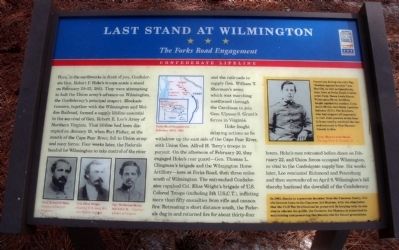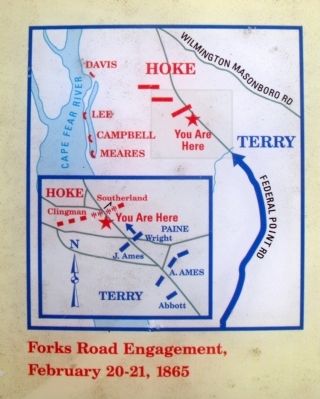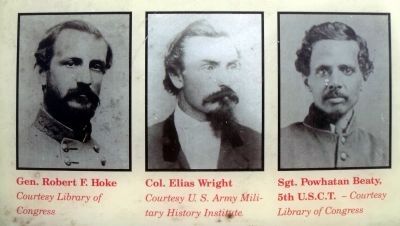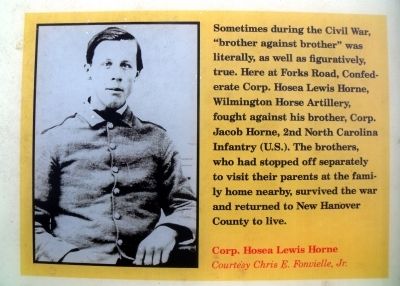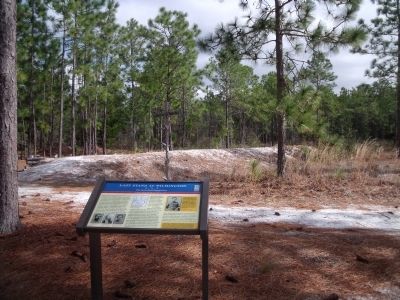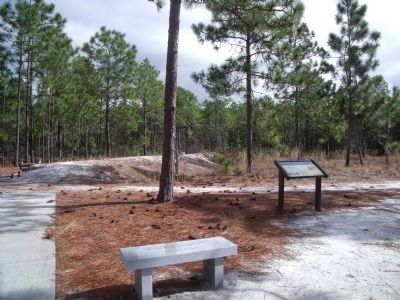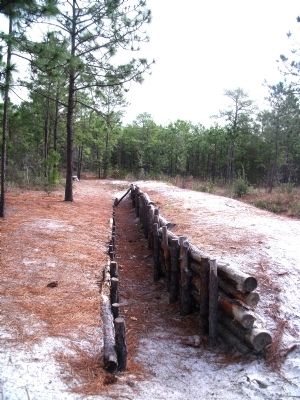Near Wilmington in New Hanover County, North Carolina — The American South (South Atlantic)
Last Stand At Wilmington
The Forks Road Engagement
— Confederate Lifeline —
Here, in the earthworks in front of you, Confederate Gen. Robert F. Hoke’s troops made a stand on February 20-21, 1865. They were attempting to halt the Union army’s advance on Wilmington, the Confederacy’s principal seaport. Blockade runners, together with the Wilmington and Weldon Railroad, formed a supply lifeline essential to the survival of Gen. Robert E. Lee’s Army of Northern Virginia. That lifeline had been disrupted on January 15, when Fort Fisher, at the mouth of the Cape Fear River, fell to Union army and navy forces. Four weeks later, the Federals headed for Wilmington to take control of the river and the railroads to supply Gen. William T. Sherman’s army, which was marching northward through the Carolinas to join Gen. Ulysses S. Grant’s forces in Virginia.
Hoke fought delaying actions as he withdrew up the east side of the Cape Fear River, with Union Gen. Alfred H. Terry’s troops in pursuit. On the afternoon of February 20, they engaged Hoke’s rear guard—Gen. Thomas L. Clingman’s brigade and the Wilmington Horse Artillery—here at Forks Road, then three miles south of Wilmington. The entrenched Confederates repulsed Col. Elias Wright’s brigade of U.S. Colored Troops (including 5th U.S.C.T.), inflicting more than fifty casualties from rifle and cannon fire. Retreating a short distance south, the Federals dug in and returned fire for about thirty-four hours. Hoke’s men retreated before dawn on February 22, and Union forces occupied Wilmington, so vital to the Confederate supply line. Six weeks later, Lee evacuated Richmond and Petersburg and the surrendered on April 9. Wilmington’s fall thereby hastened the downfall of the Confederacy.
(sidebar)
Sometimes during the Civil War, “brother against brother” was literally, as well as figuratively, true. Here at Forks Road, Confederate Corp. Hosea Lewis Horne, Wilmington Horse Artillery, fought against brother, Corp. Jacob Horne, 2nd North Carolina Infantry (U.S.). The brothers, who had stopped off separately top visit their parents at the family home nearby, survived the war and returned to New Hanover County to live.
(sidebar)
In 2002, thanks to a generous donation from the Cameron family, this site became home to the Cameron Art Museum, with the stipulation that the Civil War fortifications be preserved. In keeping with its mission to educate the public, the Cameron Art Museum is committed to maintaining and preserving this historic site for future generations.
Erected by North Carolina Civil War Trails.
Topics and series. This historical marker is listed in this topic list: War, US Civil. In addition, it is included in the North Carolina Civil War Trails series list. A significant historical month for this entry is January 1861.
Location. 34° 11.091′ N, 77° 54.892′ W. Marker is near Wilmington, North Carolina, in New Hanover County. Marker can be reached from the intersection of South 17th Street and Independence Boulevard. This marker is located northeast of the visitor parking lot of the Cameron Art Museum. Touch for map. Marker is at or near this postal address: 3201 South 17th Street, Wilmington NC 28412, United States of America. Touch for directions.
Other nearby markers. At least 8 other markers are within 4 miles of this marker, measured as the crow flies. Fall of Wilmington (approx. 0.6 miles away); North Carolina Shipbuilding Co. (approx. 1.2 miles away); State Salt Works (approx. 2.3 miles away); Edwin A. Anderson (approx. 2.6 miles away); Cassidey Shipyard (approx. 3½ miles away); Alex Manly (approx. 3.6 miles away); Gregory Normal Institute (approx. 3.6 miles away); Edward B. Dudley (approx. 3.6 miles away). Touch for a list and map of all markers in Wilmington.
More about this marker. On the lower left are photos of battle participants: "Gen. Robert F. Hoke" Courtesy Library of Congress; "Col. Elias Wright" Courtesy U.S. Army Military History Institute; "Sgt. Powhatan Beaty, 5th U.S.C.T." Courtesy Library of Congress
On the upper right sidebar is a photo of "Corp. Hosea Lewis Horne" Courtesy Chris E. Fonvielle, Jr.
Also see . . .
1. “The Stonewall of Forks Road”. Cape Fear Historical Institute entry:
General Robert F. Hoke and the Battle of Forks Road, February 20-21, 1865. (Submitted on March 18, 2010, by Bernard Fisher of Richmond, Virginia.)
2. Fort Fisher. North Carolina Historic Sites entry (Submitted on March 15, 2010, by Bernard Fisher of Richmond, Virginia.)
3. North Carolina Civil War Trails. (Submitted on March 15, 2010, by Bernard Fisher of Richmond, Virginia.)

Photographed By Bernard Fisher, March 11, 2010
8. "Thank God we stand here today as friends"
Lt. Commander James Parker, US Navy, to Colonel William Lamb, Confederate commander of Fort Fisher, at 1903 reunion of Civil war veterans.
Meditation path in memory of William Benjamin Berry III
given by the Belk Foundation
Credits. This page was last revised on August 12, 2022. It was originally submitted on March 15, 2010, by Bernard Fisher of Richmond, Virginia. This page has been viewed 2,443 times since then and 78 times this year. Photos: 1, 2, 3, 4, 5, 6, 7, 8. submitted on March 15, 2010, by Bernard Fisher of Richmond, Virginia.
